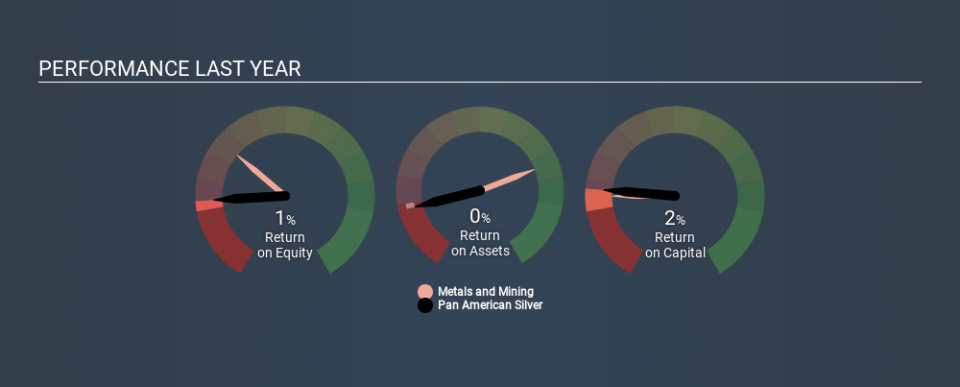Why Pan American Silver Corp.’s (TSE:PAAS) Return On Capital Employed Looks Uninspiring

Today we'll evaluate Pan American Silver Corp. (TSE:PAAS) to determine whether it could have potential as an investment idea. Specifically, we're going to calculate its Return On Capital Employed (ROCE), in the hopes of getting some insight into the business.
First of all, we'll work out how to calculate ROCE. Second, we'll look at its ROCE compared to similar companies. Then we'll determine how its current liabilities are affecting its ROCE.
Understanding Return On Capital Employed (ROCE)
ROCE is a measure of a company's yearly pre-tax profit (its return), relative to the capital employed in the business. In general, businesses with a higher ROCE are usually better quality. Overall, it is a valuable metric that has its flaws. Author Edwin Whiting says to be careful when comparing the ROCE of different businesses, since 'No two businesses are exactly alike.
How Do You Calculate Return On Capital Employed?
Analysts use this formula to calculate return on capital employed:
Return on Capital Employed = Earnings Before Interest and Tax (EBIT) ÷ (Total Assets - Current Liabilities)
Or for Pan American Silver:
0.018 = US$57m ÷ (US$3.5b - US$261m) (Based on the trailing twelve months to September 2019.)
So, Pan American Silver has an ROCE of 1.8%.
View our latest analysis for Pan American Silver
Is Pan American Silver's ROCE Good?
One way to assess ROCE is to compare similar companies. We can see Pan American Silver's ROCE is meaningfully below the Metals and Mining industry average of 3.0%. This could be seen as a negative, as it suggests some competitors may be employing their capital more efficiently. Independently of how Pan American Silver compares to its industry, its ROCE in absolute terms is low; especially compared to the ~1.9% available in government bonds. It is likely that there are more attractive prospects out there.
Our data shows that Pan American Silver currently has an ROCE of 1.8%, compared to its ROCE of 1.2% 3 years ago. This makes us think the business might be improving. You can click on the image below to see (in greater detail) how Pan American Silver's past growth compares to other companies.
It is important to remember that ROCE shows past performance, and is not necessarily predictive. Companies in cyclical industries can be difficult to understand using ROCE, as returns typically look high during boom times, and low during busts. This is because ROCE only looks at one year, instead of considering returns across a whole cycle. Given the industry it operates in, Pan American Silver could be considered cyclical. Since the future is so important for investors, you should check out our free report on analyst forecasts for Pan American Silver.
What Are Current Liabilities, And How Do They Affect Pan American Silver's ROCE?
Short term (or current) liabilities, are things like supplier invoices, overdrafts, or tax bills that need to be paid within 12 months. Due to the way ROCE is calculated, a high level of current liabilities makes a company look as though it has less capital employed, and thus can (sometimes unfairly) boost the ROCE. To check the impact of this, we calculate if a company has high current liabilities relative to its total assets.
Pan American Silver has total liabilities of US$261m and total assets of US$3.5b. As a result, its current liabilities are equal to approximately 7.5% of its total assets. Pan American Silver has a low level of current liabilities, which have a negligible impact on its already low ROCE.
What We Can Learn From Pan American Silver's ROCE
Nevertheless, there are potentially more attractive companies to invest in. Of course, you might find a fantastic investment by looking at a few good candidates. So take a peek at this free list of companies with modest (or no) debt, trading on a P/E below 20.
For those who like to find winning investments this free list of growing companies with recent insider purchasing, could be just the ticket.
If you spot an error that warrants correction, please contact the editor at editorial-team@simplywallst.com. This article by Simply Wall St is general in nature. It does not constitute a recommendation to buy or sell any stock, and does not take account of your objectives, or your financial situation. Simply Wall St has no position in the stocks mentioned.
We aim to bring you long-term focused research analysis driven by fundamental data. Note that our analysis may not factor in the latest price-sensitive company announcements or qualitative material. Thank you for reading.


